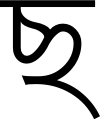Syloti Nagari, also called Sylheti Nagari, was used in northern India, what is now the Sylhet region of Bangladesh, from around 1550 AD until the 1970s. The region where it was used has been Muslim for a very long time, which might have had interesting effects on the writing system: Syloti Nagari “feels” much more like one of the Semitic abjads than any of the other Brahmi-derived languages.
Sylhet was conquered by Shah Jalal, a Muslim from Yemen, in 1303 AD. More Muslims — mostly Afghans and Central Asians — immigrated to that area as first the Hindu Hemu took over, then lost northern India to the Mughal (Turkish-speaking Mongolian Muslim) Akbar. Even during the British rule, there were still pockets of people who spoke Persian as their mother tongue in Sylhet.
Sylhet treats its vowels more cavalierly than most of the Brahmic languages. Most of the Brahmi-derived languages have a virama (also called a halant in some languages) to “kill” vowels, but Syloti Nagari did not traditionally have a virama. A virama crept into some — but not all — documents after about 1950 AD.
Another way that Brahmi-derived writing systems show that there is no vowel is to smoosh two characters together horizontally in a ligature called a conjunct. In many Brahmic writing systems, most glyphs have a vertical line; in the smooshed characters, that line is removed when the vowel is removed. In other Brahmic writing systems, the two characters are smooshed together vertically instead of horizontally. Either way, the idea gets acrossed that the vowel gets smooshed out. While the Sylheti language doesn’t have many consonant clusters in the spoken languages, it does have some; they don’t always use the appropriate conjunct, however.
- Usually conjuncts aren’t used for Arabic or Persian loanwords.
- Usually conjuncts aren’t used across morpheme (word piece) boundaries. For example, in the word “beekeeper”, “bee”, “keep”, and “er” are all morphemes.
- Frequently conjuncts are used for English loan words.
Syloti Nagari is completely unique among Brahmic writing systems in sometimes forming vowel+syllable ligatures. While most Brahmic scripts will only conjoin glyphs with consonants (e.g. “ka” + “ra” to make “kra”), Syloti Nagari will sometimes join a leading vowel glyph with a syllabic glyph, e.g. “a”+”ma” to make “ama”. Syloti Nagari will even (rarely!) smoosh together a vowel diacritic with a syllable glyph! Smooshing vowel glyphs or vowel diacritics and syllable glyphs doesn’t make any sense if you have the Brahmic idea “you smoosh glyphs together to kill vowels”, but it does make sense if you have the Arabic/Persian idea “you smoosh glyphs together in order to make the writing more smooth or beautiful”.
Finally, Syloti Nagari poetry sometimes has characters smooshed together which by rights should NOT be smooshed together — where the vowel is NOT killed. It appears that this is done in order to make the line width in the poetry work out.
All of these features suggests a Semitic attitude towards the reader, one coloured by exposure to abjads: that the reader will be able to figure out by themselves where the vowels go.
Links: Wikipedia, Omniglot, Unicode proposal, Climbing the Mountain of Languages










